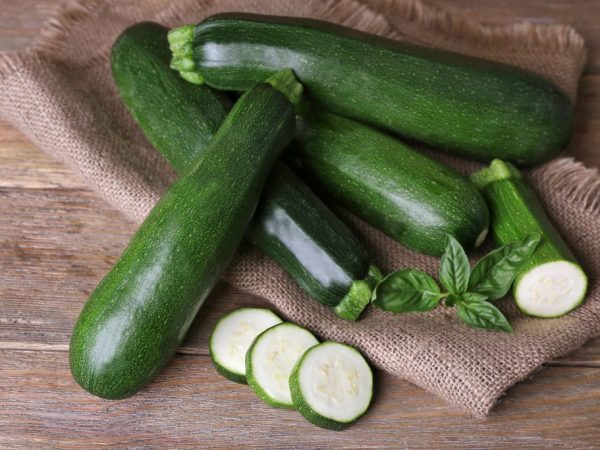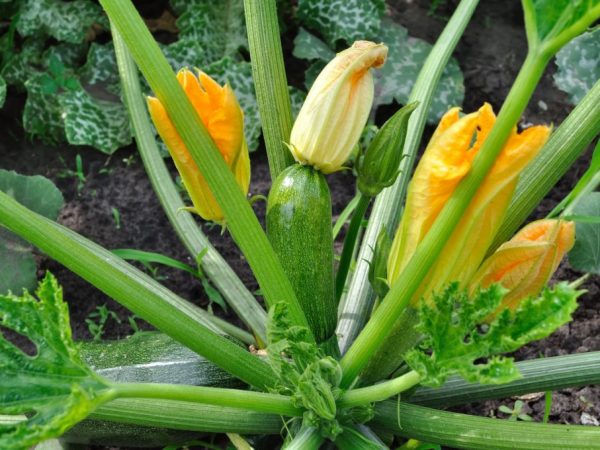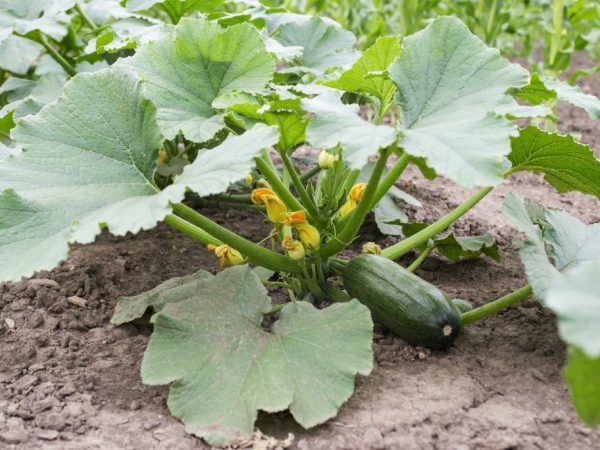Zucchini varieties Aeronaut
Zucchini Aeronaut is an early ripe variety bred in Russia. This zucchini grows in open areas and in a greenhouse. The vegetable is bred using seeds or seedlings. The aeronaut is grown both at home and in an industrial environment. This variety is characterized by its small size, fragrant pulp and fruiting up to 2 months.

Zucchini varieties Aeronaut
Features of the variety
These zucchini are classified as self-pollinating varieties. The main shoot of the fruit is short. Due to its compactness, the Aeronaut is suitable for growing on balconies. The fruit itself is green and medium in size. Leaves are thornless. This variety has mainly female flowers, which provides high yields.
Aeronaut bears fruit in late July - early August. The crop is harvested 40-45 days after the first shoots appear. Zucchini variety Aeronaut grows upward and lays down on the ground, reaching maturity.
This fruit differs from other early maturing species in such characteristics:
- frost resistance - cultivation is possible at a temperature of 10 ° C;
- growing upwards - this protects against pollution and reduces the risk of damage by insects in the ground;
- good harvest in areas with cold summers;
- compactness.
Characteristic
The bush Aeronaut is planted on the site according to the 50 × 70 scheme. It has a cylindrical ovary and thin integument with a dotted pattern. The inside of the fruit is light yellow. Ripeness is maintained until reaching a weight of 1.3 kg. The length of the ovary is about 15 cm. The pulp of the Aeronaut is white, juicy and has a pleasant aroma. The dry matter in it does not exceed 6-7%, and the sugar content varies from 2.5 to 5.5%.
Another distinctive feature of the species is its useful composition. It contains vitamins B, A, C, as well as carotene. The vegetable has the following healing properties:
- lowering blood pressure;
- increased immunity;
- protection against cancer;
- strengthening hair, nails, teeth;
- normalization of the cardiovascular system;
- improved vision;
- cleansing the skin;
- diuretic action.
Zucchini fiber provides the elimination of toxins and toxins. The vegetable has a low calorie content and is suitable for those who suffer from allergies.
Yield
Subject to the requirements for planting zucchini, up to 6-7 kg are harvested from 1 m² during fruiting. Up to 28-30 zucchini are obtained from a bush in one season.
The bushes are planted at a short distance from each other. Reducing it reduces yields.
The aeronaut is widely used in cooking. Second courses, side dishes are prepared from it, pancakes are fried. Fresh fruit is added to vegetable salads. Also, this zucchini is canned. Ripe and overripe fruits are fed to animals.
Disease resistance

Check plants regularly for slugs
The variety is immune to powdery mildew. In cold summers with light rainfall, it is not necessary to process fruits from diseases and pests. If powdery mildew or other fungi appear, the vegetable crop is treated with phytosporin. This drug is safe for humans and animals.In wet summers, slugs appear, which damage the skin, causing rot. To get rid of parasites, metaldehyde is laid around the bush.
Advantages and disadvantages
Of the advantages of zucchini, the following are distinguished:
- good yield in cool summer conditions;
- frost resistance;
- early maturity;
- compact size;
- delicate taste;
- versatility;
- low calorie content;
- possibility of transportation.
The disadvantages of growing zucchini include the following qualities:
- exactingness to care (you need frequent watering);
- short storage time for fruits.
Growing varieties
To obtain a good harvest, a number of conditions must be met:
- choose a sunny area with neutral soil; if the soil is poor, organic fertilizer is applied to it;
- produce regular watering in the morning and evening;
- when planting in a greenhouse, it is required to maintain a high level of humidity.
Good yields are obtained on black soil and floodplain lands. The aeronaut barely bears fruit on acidic soils.
It is also worth considering the crop rotation. If the zucchini is planted after the pumpkin varieties or the same plot is chosen every year, the soil will eventually deplete.
The seeds are sown in May - June. If an early harvest is required, seedlings are planted at the end of April. At first, the plant is covered with a film to protect it from temperature fluctuations. Zucchini needs surface loosening.
Tillage
To obtain a good harvest in late autumn and spring, the soil is cultivated and fertilized. Cultivation reduces the number of weeds and pests. In the middle of autumn, the soil is dug up or plowed to a depth of 27 cm. Fermented manure is introduced before cultivation (up to 6 kg per 1 m²); it is also worth using plant compost. Sometimes mineral fertilizers with nitrogen up to 80 g per 1 m² are used. Fertilizers are not applied to acidic soil, they are lime. Ash and ash are suitable for such soil.

Soil cultivation will increase the yield of plants
The earth is loosened. In the spring, the depth of loosening should not exceed 15 cm. If fertilizers were not used in the autumn period, in the second quarter 15 g of superphosphate, as well as 7 g of ammonium sulfate and potassium salt, are applied per 1 m².
After the soil has dried and before planting the vegetables, the plow is harrowed with a rake to a depth of no more than 10 cm. This allows you to remove the roots of weeds that have survived the winter, retain moisture in the ground and warm the soil well.
Seed preparation and planting
For planting, large-sized full-bodied seeds are chosen. They are soaked for a day in heated water, after which they are dried. Also, seeds are germinated 3-5 days before the first shoots appear. Effective exposure in an infusion of boric acid or potassium permanganate, because it protects against infections and bacteria.
The sprouts are sown in 6-7 cm holes in light soils and 3-5 cm in dense soils. If the ground is dry, the landing site is moistened with a glass of water. The hole takes 3 seeds. After planting, dry earth is poured on it, and then compacted well.
Do not grow more than 13 bushes on 10 m², this allows you to exclude excessive moisture in the soil.
Care
Irrigation measures are required for the Aeronaut at the stage of ovary formation. Too much watering leads to excess moisture accumulation in the zucchini squash. This negatively affects its quality and shortens the storage time.
During the growing season, three main dressings are made. The first takes place at the flowering stage, it involves the use of fertilizers with nitrogen. For the following dressings, organic products are used. They are applied in a volume of 1 liter per bush.
Conclusion
Zucchini of the Aeronaut variety is a tasty and healthy product that is popular with gardeners due to some of its advantages. To get a high yield, the farmer must follow the rules for growing this crop.

